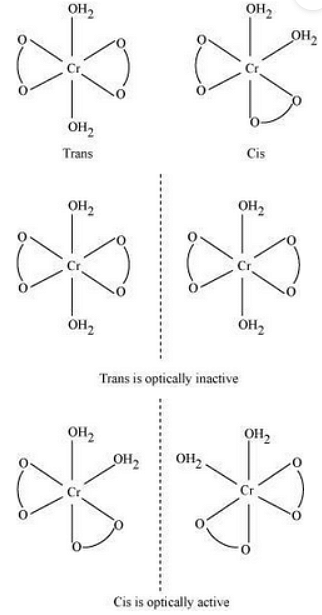Write down the IUPAC name for each of the following complexes and indicate the oxidation state, electronic configuration and coordination number. Also give stereochemistry and magnetic moment of the complex:
\((i) K[Cr(H_2O)_2(C_2O_4)_2].3H_2O\)
\((ii)[Co(NH_3)_5Cl]Cl_2\)
\((iii) CrCl_3(py)_3\)
\((iv) Cs[FeCl_4]\)
\((v)K_4[Mn(CN)_6]\)
Write down the IUPAC name for each of the following complexes and indicate the oxidation state, electronic configuration and coordination number. Also give stereochemistry and magnetic moment of the complex:
\((i) K[Cr(H_2O)_2(C_2O_4)_2].3H_2O\)
\((ii)[Co(NH_3)_5Cl]Cl_2\)
\((iii) CrCl_3(py)_3\)
\((iv) Cs[FeCl_4]\)
\((v)K_4[Mn(CN)_6]\)
Solution and Explanation
(i) Potassium diaquadioxalatochromate (III) trihydrate.
Oxidation state of chromium=3
Electronic configuration: \(3d ^{3} : t_{2g}^ 3 \)
Coordination number = 6 Shape: octahedral
Stereochemistry:
Magnetic moment, \(ÃŽÂ\frac{1}{4}=\sqrt{n(n+2)}\)
\(=\sqrt{3(3+2)}\)
\(=\sqrt{15}\)
\(∼ 4BM\)
\((ii) [Co(NH_3)_5Cl]Cl_2 \)
IUPAC name: Pentaamminechloridocobalt(III) chloride
Oxidation state of \( Co=+3 \)
Coordination number=6 Shape: octahedral.
Electronic configuration: \(d ^{6} : t_{2g}^ 6 .\)
Stereochemistry:

Magnetic Moment=0
\((iii) CrCl_3(py)_3 \)
IUPAC name: Trichloridotripyridinechromium (III)
Oxidation state of chromium = +3
Electronic configuration for \(d^{ 3} = t_{2g}^ 3 \)
Coordination number = 6
Shape: octahedral.
Stereochemistry:
Both isomers are optically active.
Therefore, a total of 4 isomers exist.
Magnetic moment\(, ÃŽÂ\frac{1}{4}=\sqrt{n(n+2)}\)
\(=\sqrt{3(3+2)}\)
\(=\sqrt{15}\)
∼ 4BM
\((iv) Cs[FeCl_4] \)
IUPAC name: Caesium tetrachloroferrate (III)
Oxidation state of\( Fe = +3\)
Electronic configuration of \(d ^{6} = eg^{ 2} t_{2g}^ 3 \)
Coordination number = 4 Shape: tetrahedral
Stereochemistry: optically inactive Magnetic moment: \(ÃŽÂ\frac{1}{4}=\sqrt{n(n+2)}\)
\(=\sqrt{5(5+2)}\)
\(=\sqrt{35}\)
~6BM
\((v) K_4[Mn(CN)_6]\) Potassium hexacyanomanganate(II)
Oxidation state of manganese=+2
Electronic configuration: \(d ^{5+}: t_{2g}^ 5 \)
Coordination number = 6 Shape: octahedral.
Streochemistry: optically inactive
Magnetic moment,\( ÃŽÂ\frac{1}{4}=\sqrt{n(n+2)}\)
\(=\sqrt{1(1+2)}\)
\(=\sqrt{3}\)
\(=1.732BM\)
Top Questions on Coordination Compounds
The correct IUPAC name of \([ \text{Pt}(\text{NH}_3)_2\text{Cl}_2 ]^{2+} \) is:
- CBSE CLASS XII - 2025
- Chemistry
- Coordination Compounds
- Write the anode and cathode reactions and the overall cell reaction occurring in a lead storage battery during its use.
- CBSE CLASS XII - 2025
- Chemistry
- Coordination Compounds
- Calculate the potential for half-cell containing 0.01 M K\(_2\)Cr\(_2\)O\(_7\)(aq), 0.01 M Cr\(^{3+}\)(aq), and 1.0 x 10\(^{-4}\) M H\(^+\)(aq).
- CBSE CLASS XII - 2025
- Chemistry
- Coordination Compounds
- The number of non-ionizable valences of Co$^{3+}$ and Pt$^{4+}$ ions in the complexes CoCl$_3\cdot5$NH$_3$ and PtCl$_4\cdot5$NH$_3$ is respectively
- TS EAMCET - 2025
- Chemistry
- Coordination Compounds
- Permanganate titrations cannot be performed satisfactorily in presence of HCl. The reason is
- TS EAMCET - 2025
- Chemistry
- Coordination Compounds
Questions Asked in CBSE CLASS XII exam
- Find: \[ \int \frac{2x}{(x^2 + 3)(x^2 - 5)} \, dx \]
- CBSE CLASS XII - 2025
- Integration
- If \( \int \frac{1}{2x^2} \, dx = k \cdot 2x + C \), then \( k \) is equal to:
- CBSE CLASS XII - 2025
- Integration
- Two dice are thrown. Defined are the following two events A and B: \[ A = \{(x, y) : x + y = 9\}, \quad B = \{(x, y) : x \neq 3\}, \] where \( (x, y) \) denote a point in the sample space. Check if events \( A \) and \( B \) are independent or mutually exclusive.
- CBSE CLASS XII - 2025
- Probability
- Find the least value of ‘a’ so that $f(x) = 2x^2 - ax + 3$ is an increasing function on $[2, 4]$.
- CBSE CLASS XII - 2025
- Functions
- Light consisting of two wavelengths 600 nm and 480 nm is used to obtain interference fringes in a double slit experiment. The screen is placed 1.0 m away from slits which are 1.0 mm apart. (i) Calculate the distance of the third bright fringe on the screen from the central maximum for wavelength 600 nm.
- CBSE CLASS XII - 2025
- electrostatic potential and capacitance
Concepts Used:
Nomenclature of Coordination Compounds
Nomenclature of Coordination Compounds is important in Coordination Chemistry because of the need to have an unambiguous method of describing formulas and writing systematic names, particularly when dealing with isomers.
We can apply the following formulas:
- On the very first the central atom is listed.
- Ligands are then listed in alphabetical order and their placement in the list does not depend on their charge.
- Polydentate ligands are also listed alphabetically. In such a case of an abbreviated ligand, the first letter of the abbreviation is used to determine the position of the ligand in alphabetical order.
- The formula for the entire coordination entity is enclosed in square brackets whether charged or not. The formulas are enclosed in parentheses when ligands are polyatomic. Ligand abbreviations are also enclosed in parentheses.
- Within a coordination sphere, there should be no space between the ligands and the metal.
- When the formula of a charged coordination entity is to be written without that of the counter-ions, the charge is indicated outside the square brackets as a right superscript with the number before the sign. For example, [Co(CN)6]3-, [Cr(H2O)6]3+, etc.
- The charge of the anion(s) balances the charge of the cation(s).